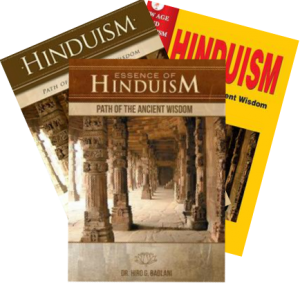Ayurveda is a Sanskrit word that means “knowledge of life.” It is an ancient indigenous medical science of the Hindu culture, more than five thousand years old. The source of this science lies in Rig Veda and Athar Veda. Three most important names are associated with Ayurveda: Dhanvantri, the mythological god is regarded as the divine father of Ayurveda; Sushruta (600 BCE), father of Indian surgery, who performed more than 300 types of surgical operations and invented many sophisticated instruments; Acharya Charaka (100 CE), who wrote the “Charaka Samhita”, and is known as father of Indian medicine. It has been said that the Vedic sciences are really “one integral science, with many windows.” Like many others, this gem of the old Indian civilization is dazzling even today, perhaps more brightly than at any time in the history of mankind. It has come to occupy a position of dignity and honor, which was long overdue. There are number of ayurvedic centers, which now command a health-conscious, nature-loving, and sophisticated clientele. Ayurveda is fast becoming an integral part of many spas, yoga centers, and wellness clinics all over the West.
The ayurveda system is based more on promotion of the physical, mental, and spiritual well-being and balance than on treatment of illness. Modern medicine has long paid attention to the pathological state of various ailments and has been primarily concerned with treatment of the disease and symptoms. Ayurveda, on the other hand, treats the whole being, going to the root cause of the discomfort and its aggravation and giving a basic plan of action for disease prevention. Modern medicine only recently has turned its direction toward preventive aspects.
Ancient Rishis of India conceived that our cosmos is made of five basic elements of matter: space, air, fire, water, and earth. Man, too, is made from these five basic elements. According to the modern science of physics, all matter is made of molecules and atoms. More recently, studies have revealed that these atoms may be further reduced to the minutest quantum fluff, which may be ten million to one hundred million times smaller than the smallest of atoms. At the quantum level, energy and matter are transferable; the particles move constantly. At that level, the rock on a mountain is no more a static and immovable entity, but there is a lot of quantum activity going on. The matter and energy are not destructible. Thus, we may be breathing the very same air that our ancestors breathed five thousand years ago—or perhaps even five million years ago!85
According to Ayurveda, the interaction of the body humors, called doshas, determines the physical as well as the mental makeup of an individual. The therapy is essentially directed at wholesome vegetarian food, a righteous and pure living style, and natural healing remedies. Ayurveda maintains that human beings are classified in three major groups according to their dosha as: vata: space + air; pitta: fire + water; and kapha: water + earth.
Vata types, like their constituents of space and air, move quickly and lightly. When vata is aggravated, it brings on the vata qualities of being dry, rough, and mobile, because water is not a part of them. In such cases, people are more likely to suffer from anxiety, insomnia, nervous disorders, arthritis, and constipation. All the vata therapies must be directed toward nurturing, moistening, and calming. They may benefit from good rest and sleep. They should avoid over-stimulation and emotionally tense situations. Vata types should avoid iced drinks, sodas, caffeine, and dry, rough foods. Heavy oils, such as sesame, may be used for massage. Meditation, pranic breathing, calming and grounding yoga exercises would play a major part in balancing vata.
Pitta types constitute the fire and water and are hot, sharp, and acidic. They are of medium bone structure, muscular, and can gain or lose weight easily. They are pink and oily in complexion. They are irritable and impatient in temperament but are forceful and aggressive in nature. They spend their energies moderately. All the pitta therapies should be cooling and calming. They should avoid over-exertion, as they may burn out. They must relax in nature. They are ambitious and have drive. They have a sharp intellect and are prone to anger. They also are prone to rashes, inflammation, and ulcers. They must plan to cool down. Foods that are sweet, bitter and astringent, cooling, and alkaline in nature, such as fruits and juices, would be recommended. Alcohol, tobacco, and coffee must be avoided. Massage with cool and light oils, such as coconut and sunflower.
Kapha types likewise are made of water and earth and are heavy, oily, cold, and steady. They are strong and tend to gain weight easily. They have a heavy and prolonged sleep. They are usually easygoing. They are self-centered but are also loyal and steady. They are lethargic in nature. All therapies are directed toward reducing, stimulating, and drying. They are also more vulnerable to colds, congestion, and diabetes. Dry massage or light oil, such as mustard, may be used. Stimulating asanas (yogic postures) are advised.
This classification, however, is not absolute. Combinations of various doshas with dominance of any one may exist. A proper evaluation by an expert would be helpful. Special panchakarma treatment schedules are prescribed in the ayurveda system, which include an individual customized diet, laxatives, herbal oil massages, sweat therapy, enemas, and nasal irrigations.
In ayurveda, as in all other Hindu philosophies, the main emphasis is on the spiritual aspect. A person is taught to look within, to contemplate, to meditate, to tune himself to the divine wisdom, and to balance in harmony, wherever he finds fault and shortcoming. To achieve this balance and harmony is the main task of an ayurvedic specialist. His role, however, remains that of a guide; the person concerned has to do most of the work himself
In recent times, Ayurveda has gained a prodigious status, with its main emphasis being “natural treatment” in place of chemicals and synthetics used in modern medicine, often accompanied by severe toxic reactions. From the Hindu viewpoint, the secular and the spiritual invariably go hand in hand. In fact, the “spiritual” often plays the dominant and supervisory role. Ayurveda centers are becoming more popular even in Western countries, because of their simple natural methodology.
Ayurveda lays more importance on the “prevention” aspect of disease, rather than its cure. Ayurveda teaches that a person becomes sick mainly because he/she transgresses the natural laws of health. The recent high prominence of organic foods, vegetarianism, massage therapy, yoga, meditation etc. is linked with the Ayurveda philosophy.
In ayurveda, as in all other Hindu philosophies, the main emphasis is on the spiritual aspect. A person is taught to look within, to contemplate, to meditate, to tune himself to the divine wisdom, and to balance in harmony, wherever he finds fault and shortcoming.




